As an Amazon Associate I earn from qualifying purchases.
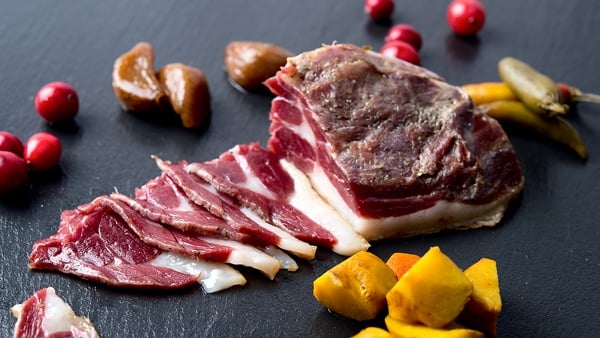
I’ve always wondered why we all call cured duck breast “duck prosciutto.” After all, a ham is the hind leg of a pig, so shouldn’t duck or goose ham be the hind leg of the bird?
Apparently the Italians think so, too, because their prosciutto d’oca (oca means goose in Italian) is indeed made from the legs of geese.
I have a couple excellent books on Italian charcuterie written in Italian, which I can read just enough to be dangerous. In these books it describes prosciutto d’oca, also known as prosciuttino d’oca, as a fairly common cured meat found in Friuli, in the far northeast corner of Italy.
Problem is that as a hunter, you need a particular kind of goose leg to make this ham. A leg/thigh from a big Canada goose that had been eating grain — so it had a nice fat layer — would be an ideal wild leg to use. Smaller but better tasting would be a leg from a specklebelly goose.
But I had none lying around.
Fortunately I had some domesticated goose from Schiltz Farms they’d given me to help me with research for my cookbook Duck, Duck, Goose. I’d already used the breasts to make German smoked goose breast, which, by the way is made of awesome. That left the legs.
It takes courage to make this prosciutto. It requires a very long hang time, almost as long as that of a regular ham. Keeping the meat moist over several months without a massive mold invasion was a little tricky, but keeping an eye on the humidity of the curing chamber and of the various molds that developed turned out to be easier than I’d thought.
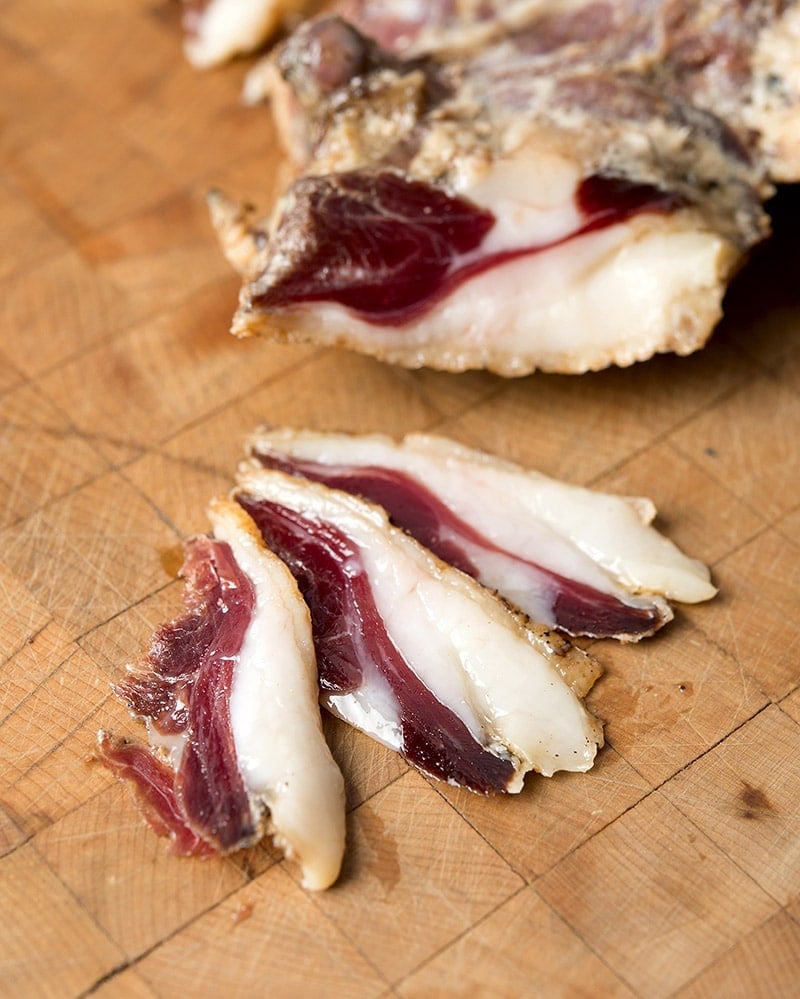
The long wait was worth it. This ham is nothing short of amazing.
The fat melts on your tongue like a good lardo, and the meat is moist, a little funky and is so smooth it’s like eating silk. A little bit goes a long way, which is good because the yield isn’t fabulous. You get a nice chunk from the thighs, as you can see in the lead photo up top, and then little shavings here and there.
My guess is that there is a customary way to cut this ham, as there is with Spanish hams like jamon iberico, but I haven’t mastered that yet.
Prosciutto d'Oca, Italian Goose Leg Ham
Ingredients
- 2 goose leg/thighs, preferably from a large domestic goose or a fatty Canada or specklebelly
- 88 to 132 grams of kosher salt, or 3 to 4 1/2 ounces
- 5 to 7 grams Instacure No. 2, about 1 teaspoon
- 1/3 cup cracked black pepper, divided
- 1 teaspoon ground nutmeg
- 1 tablespoon ground bay leaves
- About 1 cup of lard or duck fat
- 1/4 cup cracked coriander seeds
Instructions
- Start the process by trimming away any large gobs of fat around the leg and thigh. You do want lots of fat on the ham itself, but only that covering the rest of the leg. Fat pockets on the side need to go.
- Mix together the salt, Instacure, 2 tablespoons of black pepper, the nutmeg and bay leaves and massage it into the goose legs. Make sure every part of the goose gets a coating of the salt cure, especially around the ball joint that used to attach the thigh to the rest of the goose; this is an area that can go rancid easily if there's no cure on it. Put the goose legs and any remaining cure into a lidded container just about large enough to hold both legs. Cure in the fridge until firm throughout, about 7 to 10 days. Every day, alter the position of the legs so each side of each leg gets good contact with the salty slurry that develops as the cure draws moisture from the goose legs.
- When the legs are cured, give the legs a quick rinse under cold water. You want most, but not all, of the cure to be washed away. A little stray bit of cure here and there adds flavor later. Pat the legs dry with paper towels and let them dry out for 24 to 48 hours. Do this either by putting the legs on a rack in the fridge or by hanging in your curing chamber at between 50°F and 55°F.
- Now you are ready for the long cure. Use kitchen twine to tie a line from the end of the drumstick so you can hang your legs in the curing chamber. Pat the meat side of each leg dry with a paper towel. Smear on a thick layer of lard or duck fat onto the meat side and sprinkle it heavily with the cracked black pepper and coriander seeds. This process keeps the meat underneath moist over the following months. The spices help prevent spoilage and keep away flies.
- Hang the legs at between 50°F and 60°F in a humid environment, between 65 percent and 80 percent humidity, for a minimum of 2 months. I hung mine for 6 months, and it was sublime. Over time in the curing chamber the legs will develop some mold. This is normal. Keep an eye on the mold and remove any black mold as soon as you see it. If this develops on the lard patch (it did on mine), wipe it off and replace the lard and black pepper coating. Just be sure to check the goose legs every few days or so.
- Once the ham is ready, wipe off the lard cap, removing as much as you can from the meat side of the goose thigh. Slice thin and serve on a charcuterie plate, or in a sandwich.
Notes
Nutrition information is automatically calculated, so should only be used as an approximation.

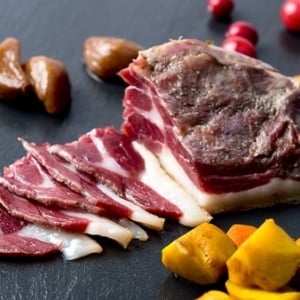
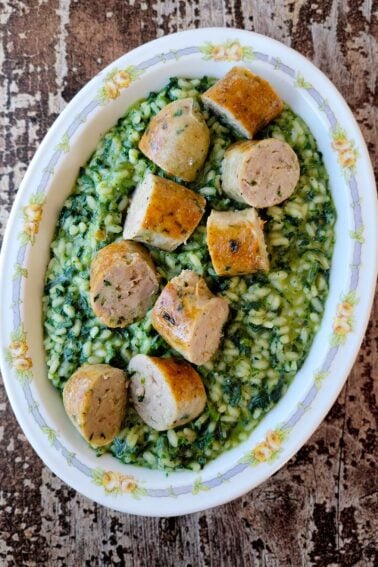
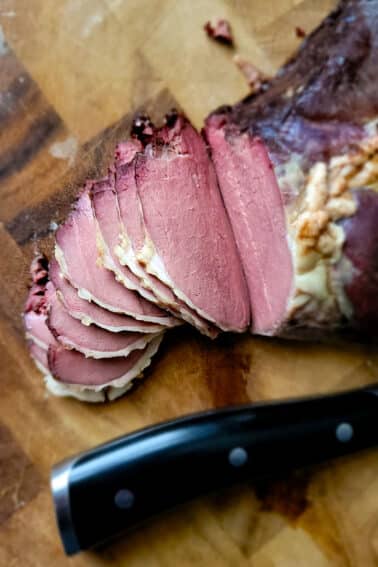
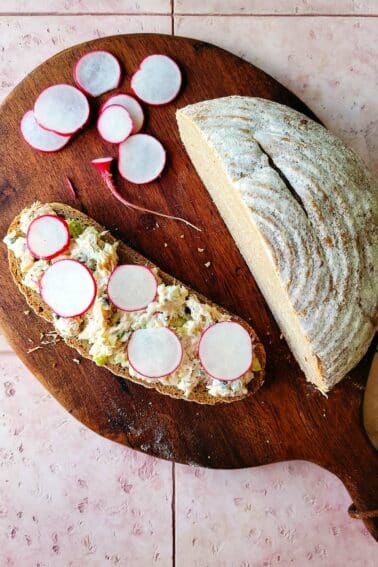
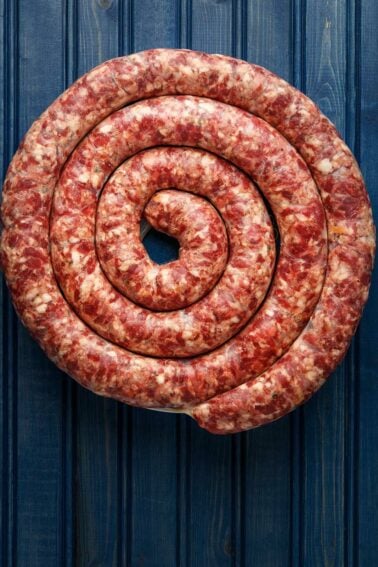
Hank! You sir – are always my first go to for delving into the recipes that use wild game… and foraged foods. (Ramps, hazels, mushrooms and more!)
I’ve made several batches of your goose pastrami, bought many of your books for friends to encourage their adventures in cooking.
Growing up in northern Ontario, we learned how to hunt, fish, gather and chef up. From homemade corned moose and sauerkraut to double smoked and aged partridge kielbasa.
I appreciate your sharing of these traditions…. And the upscale flair of your take on traditional recipes and processes.
Cheers,
Kelsey
From Hornepayne
(A place that would suit you well)
Hank, I made some prosciutto and cut into it during the summer 2021, out of breast. It aged for about 2 months. Now, it got Lost in the Fridge in a ziplock bag and recently found. Meat looks good after cutting a thin slice off the end ; deep dark red color. What are your thoughts on ediblebility? Doesn’t smell bad, no black or off color mold. No mold at all actually. I sliced off a tiny thins slice, ate it, and it was really salty but otherwise seemed fine. How long do they last in fridge after you are done aging? This one is going on probably 8, 9 months now.
Dave: Should be fine. All that salt helps preserve things for a long long time.
Great, thanks Hank. To give you an update, I couldn’t stop at the small slice and ate “a few” slices and to your point, I’m fine. Super surprises atvhow long it’s kept. And to give an update, I had used the drying bag and it worked fine for all the rookies out there that don’t or can’t invest in a curing chamber. Thanks Hank, you’re my go to for recipes and thoroughly enjoy your books! Next on the list is goose bacon, now that my smoker has a cold smoker attachment!
Hank, With this recipe, as I don’t have a curing chamber, I will be using one of those “dry age bags” one can purchase from suppliers. Any suggestions on doing things differently from above? I plan to monitor weight halfway to 60 days, and no fat was added, but otherwise mirrored your recipe, so any suggestions would be welcome.
Dave: Sorry, I’ve never used one. Not sure how it would be different.
Also a question on time in the cure. Both legs weighed 1 lb. 5oz. combined weight, would I leave them in the cure for only 1/2 the time…say 3-5 days?
I get to smoke my Canada Goose pastrami tomorrow and the legs are a day into their cure for this particular project. A question on hang time. With other similar dry curing projects I’ve completed(coppa, duck prosciutto), the amount of time the meat was left to hang was based on the percent of overall weight lost (30%). At 30% weight loss the meat was considered safe to eat. Would the same apply here?
Kevin: Yes, 30% is fine, and yes, a cure of about 3 to 5 days is about right.
With this recipe, as I don’t have a curing chamber, I will be using one of those “dry age bags” one can purchase from suppliers. Any suggestions on doing things differently from above? I plan to monitor weight halfway to 60 days, and no fat was added, but otherwise mirrored your recipe, so any suggestions would be welcome.
Yes, Christchurch
Hi Hank, would this work on Black Swan legs?
Robert: Quite well, I imagine. I guess you are from New Zealand?
Eddie: Yeah, it’s mostly for insurance, and color.
Oh this sounds fabulous. For whole muscle curing you shouldn’t need insta-cure, right? It’s just insurance?
Doug: Nope. You need the skin to be on, otherwise the meat will dry out too much.
Awesome! Next time I am going to try this recipe!
Whenever I see you post this previously-unknown-to-me stuff, I feel like Jack Nicholson’s Joker in that Batman movie:
“Where does he get all those wonderful toys?!?!?!”
I remove the legs from the honkers I shoot. But I pull the skin off. Can I still make this with out the skin on the legs and thighs??
Odd, the CAPTCHA for this post is U238, or uranium. Are you reading this, NSA? – More to the point, Mr. Shaw, how about showing a conversion or giving a gram quantity for “red salt”. A brief netsearch does not have a useful conversion equation or similar.
I just finished curing a pancetta (a good starting point in charcuterie, in my opinion), but looks like I’ve found my next project!